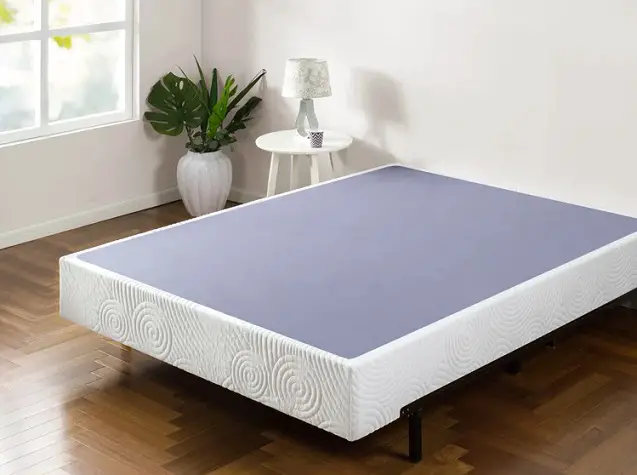Whether buying a bed frame for a youngster or an adult, weight capacity is crucial. The weight limit protects sleeper safety and bed frame durability.
However, bed frame weight capacity is difficult to determine. Bed frame weight limitations are not defined, and many manufactures do not clearly show this information. The materials, design, and purpose of a bed frame affect its weight limit.
Know a bed frame’s weight limit before lying down. Overweight bed frames can bend, droop, or break, endangering sleepers. Thus, knowing a bed frame’s weight capability is crucial for safety and durability.
In the following sections, we will discuss bed frame materials and types, their average weight restrictions, and factors that affect them.
With this knowledge, you may choose a bed frame that meets your demands and supports a comfortable and safe sleep environment.
Table of Contents
Understanding the Weight Limit of a Bed Frame
There are other factors besides the weight of the sleepers to think about when determining the weight limit of a bed frame. It is the total weight of the mattress, box springs, bedding, and occupants that manufacturers use to establish this limit.
This thorough evaluation guarantees that the bed frame will hold up under the weight of the full bed and bedding arrangement.
Knowing how much everything weighs is essential to making sure you don’t go over your weight limit. Let’s examine the typical component weights in more detail.
Mattress
Full-size mattresses generally weigh around 56 pounds, while queen-size mattresses can weigh around 70 pounds. The weight of mattresses can vary depending on factors such as size, material composition, and additional features. For instance, some specialized mattresses or larger sizes might weigh up to 150 pounds.
Box Springs
Traditional box springs, which provide additional support for the mattress, can weigh between 30 to 100 pounds, depending on their size and construction. Newer bed frame designs may eliminate the need for box springs, which can affect the overall weight calculation.
Bedding
The weight of bedding materials, such as sheets, blankets, and pillows, is generally negligible compared to the weight of the mattress and box springs. When considering the weight capacity of a bed frame, it’s still important to account for the combined weight of these items for a more accurate calculation.
Weight Limits of Standard Bed Frames
The maximum allowed weight for standard bed frames varies by the type of construction used in the frame. There is no set maximum load capacity for a bed frame, but most can easily handle the weight of two average-sized individuals. Manufacturers and bed frame models can put differing constraints on this weight.
When used properly, most ordinary bed frames can support up to 500 pounds of weight. Most singles and couples shouldn’t need to worry about exceeding this weight limit.
The total weight of the mattress, box springs, bedding, and sleepers must be taken into account to guarantee that it is below the maximum safe weight.
Over time, a bed frame might sustain structural deterioration if it supports more weight than is recommended. Bed frames that sag in the middle, make creaking noises, or show obvious signs of tension are clearly trying to hold your weight. Therefore, to prolong the life of the bed frame, one should not exceed the recommended weight.
Evenly distributing weight throughout a conventional bed frame is crucial to maximizing the frame’s longevity and ensuring its best function.
Extra support, such a middle leg or a solid platform, can assist distribute weight evenly over the frame and alleviate strain on individual parts.
Different manufacturers will typically list different weight limits for their regular bed frames. If you have questions or special needs about the product’s weight capacity, it is best to check with the manufacturer directly.
Weight Limits of Wood Bed Frames
Durability, aesthetics, and versatility make wood bed frames attractive. Wood bed frames’ weight capacities vary by wood type, frame construction, and support systems.
Wood bed frames typically hold 500 pounds. However, solid wood bed frames have higher weight limits than those with wooden slats or a mix of wood and other materials.
Solid wood platform beds are the strongest wood bed frames. They can support 900 pounds or more, making them suited for heavier people or couples. These frames have a sturdy wood foundation.
The thickness and spacing of wood bed frames with slats are crucial. Closely spaced, thicker slats improve weight distribution and frame capacity. Due to poor support, bed frames with widely spaced slats may have a reduced weight capacity.
Wood bed frames might be sleigh, panel, or poster beds. These types might improve the bedroom’s attractiveness, but make sure they can support your weight. Most wood bed frames can accommodate two average-sized adults, but check the manufacturer’s weight limits.
Wood platform beds are also good for heavier people. Platform frames don’t need box springs because they’re lower. The strong wood platform directly supports this sleek and futuristic design, increasing weight capacity.
Weight Limits of Metal Bed Frames
Metal bed frames are strong and versatile. Metal bed frames’ weight capacities depend on the metal, frame structure, and reinforcement elements.
The weight capacity of metal bed frames depends on the metal type and thickness, contrary to the belief that metal is stronger than wood. Heavy-duty steel makes the strongest metal bed frames.
Wrought iron beds, a common metal bed frame, can hold 600–800 pounds, depending on size and design. These frames are stylish and sturdy.
Modern metal bed frames sometimes combine metal with polymer resin or other materials to increase strength and weight capacity. Depending on design, materials, and reinforcement, hybrid frames can support 250 to 5,000 pounds.
Platform bed frames offer larger weight capacities than slatted metal frames. Platform frames directly support the mattress without box springs. Thus, depending on design and construction, metal platform bed frames can hold 600 to 3,500 pounds.
Metal bed frames are strong, although weight capacities vary by model and manufacturer. Thus, before buying a metal bed frame, check the manufacturer’s weight restriction guidelines.
Consider design, structure, and materials when choosing a metal bed frame. Heavy-duty steel or wrought iron bed frames are stronger and can hold more weight. Center legs or extra support bars can improve the frame’s load capacity.
Heavy-Duty Bed Frames for Heavier Persons
Bed frames for larger people or families who co-sleep have become increasingly popular. Several manufacturers have created heavy-duty bed frames for heavier weights.
Steel and other strong metals are used to make heavy-duty bed frames. These frames are reinforced to accommodate heavier weights without affecting stability or structural integrity.
Heavy-duty bed frames typically hold 2,000–5,000 pounds. These frames are designed to support heavy weight without bowing or drooping, giving a safe and comfortable sleep.
Heavy-duty bed frames can support and last longer for larger people or families who co-sleep. These frames can bear heavy weight without affecting stability or longevity, giving peace of mind.
Consider the manufacturer’s weight capability when choosing a heavy-duty bed frame. Check the materials, workmanship, and any reinforcements like extra support legs or crossbars.
Heavy-duty bed frames frequently have a lower profile, lowering the mattress. This design can help those with mobility issues and look better.
Heavy-duty bed frames are not just for heavy people. These frames are great for heavy-duty bed frames.
Tips for Choosing the Right Bed Frame
Choosing the right bed frame is crucial for ensuring optimal support, comfort, and safety while you sleep. Consider the following tips when selecting a bed frame:
Consider Your Mattress Size
The bed frame you choose should match the size of your mattress. Measure your mattress before purchasing a bed frame to ensure a proper fit.
Keep in mind that some mattresses come in variations, such as XL twin or California king, so be sure to select a bed frame that accommodates your specific mattress size.
Evaluate the Materials
Select a bed frame made from strong and durable materials. Popular choices include wood, metal, or a combination of both.
Consider the pros and cons of each material, such as durability, weight capacity, and aesthetic appeal, to find the best option for your needs.
Assess the Height
The height of the bed frame can impact your comfort and ease of use. Lower bed frames may be more accessible for individuals with mobility concerns or shorter stature, while higher bed frames can provide additional storage space underneath. Choose a height that suits your preferences and physical needs.
Determine Weight Capacity
Before purchasing a bed frame, ensure that it can support the combined weight of the mattress, box springs, bedding, and sleepers.
Take into account the weight limits discussed earlier in this article and choose a bed frame that exceeds your specific weight requirements to ensure adequate support and longevity.
Consider Additional Features
Some bed frames offer extra features that can enhance your sleeping experience. For example, adjustable bed frames allow you to customize the position of the head and foot of the bed, while storage bed frames provide built-in storage compartments. Evaluate these additional features based on your personal preferences and needs.
Assess Stability and Support
Stability and support are crucial for a comfortable and safe sleep environment. Look for bed frames that offer sturdy construction, reliable support systems such as center legs or extra support bars, and positive customer reviews regarding stability and durability.
Consider Aesthetics and Style
Bed frames come in various designs, styles, and finishes. Consider the overall aesthetic of your bedroom and choose a bed frame that complements your existing décor.
Whether you prefer a traditional, modern, or minimalist style, there are plenty of options available to match your personal taste.
Read Reviews and Seek Recommendations
Before finalizing your decision, read customer reviews and seek recommendations from friends or family members who have purchased bed frames.
Their experiences can provide valuable insights into the quality, durability, and overall satisfaction with different bed frame options.
Conclusion
A comfortable, supportive, and safe sleep environment depends on the bed frame. Understanding the elements that affect weight capacity and the typical weight restrictions for different materials and types of bed frames will help you choose.
Put into consideration the weight of the mattress, box springs, sheets, and sleepers while choosing a bed frame. This will avoid bed frame deterioration, sagging, and failure.
Consider mattress size, materials, height, weight capacity, and any other aspects that may improve your sleep when choosing a bed frame. For stability, consider a bed frame composed of wood or heavy-duty steel with center legs or extra support bars.
Consider these characteristics and follow the guidelines to choose a bed frame that meets your demands, supports your weight, and matches your style. Your bed frame will be durable and comfortable if you prioritize safety, durability, and comfort.
Remember, the bed frame is one of the most crucial parts of your sleeping setup, and investing in a durable and appropriate one will pay off in comfort and longevity. You’ll have a bed frame that supports your sleep for years if you research, measure, and evaluate your demands.

